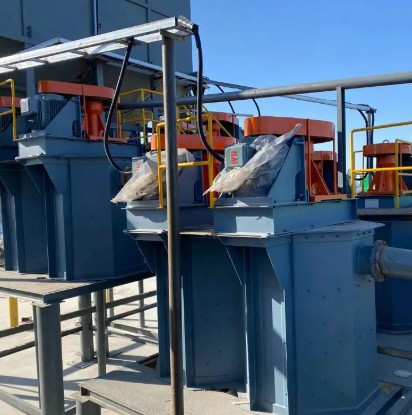NEWS&EVENTS
Home > News&Events > Company news > The core principle of copper extraction from heap leaching of copper oxide ore
The basic principle of heap leaching is to spray a solvent, such as dilute sulfuric acid, onto a pile of crushed copper oxide ore. The solvent, under the influence of gravity, permeates the ore pile, reacting chemically with the copper oxide minerals, converting the copper into a soluble copper sulfate solution. The copper-containing solution (called "precious solution" or "leachate") is then collected and the metallic copper is recovered through a subsequent extraction-electrodeposition process.
The following are the core steps of heap leaching:

Yard Preparation: Select a flat, impermeable plot of land. First, lay a high-quality, high-density polyethylene (HDPE) impermeable membrane to prevent solution leakage and contamination of groundwater and soil. A layer of clean gravel will be laid on the membrane as a base, and a solution collection pipe will be buried.
Pile Construction: Prepared ore is deposited onto an impermeable stockpile using large trucks or conveyor belts. Pile construction is a complex process, requiring specialized equipment (such as a crawler concrete spreader) to spread the ore layer by layer. This prevents excessive compaction by vehicles, maintaining a loose and porous structure and ensuring even solution flow. Pile construction can range from several meters to over ten meters high.
Sprinkler system layout: Lay a pipe network system on the top of the ore pile and install sprinklers or drip irrigation tape. Drip irrigation systems are more effective than sprinklers, reducing water evaporation losses and acid mist generation.
Spray Leaching: A prepared dilute sulfuric acid solution (typically with a pH of 1-2) is pumped to the top of the heap via a pump and pipe and evenly sprayed onto the surface of the ore. The solution slowly seeps downward under gravity, dissolving the copper in the ore and forming a copper-containing leachate.
Solution collection: The leachate flows out from the bottom of the pile and flows into a special "precious liquid pool" through the collection pipe at the bottom.
In summary, from laying an impermeable base mat and scientifically constructing the heap, to deploying a drip irrigation system for precise spraying, and finally successfully collecting the copper-rich precious liquid, every core step of the heap leaching process is aimed at efficiently and environmentally recovering copper resources from low-grade ore. The solution collected in the precious liquid tank serves as the feedstock for the subsequent extraction-electrodeposition process, ultimately being refined into a high-purity cathode copper product. The successful operation of this series of processes not only significantly reduces the energy consumption and cost of ore processing, but also minimizes the environmental impact through strict anti-seepage measures, fully demonstrating the close integration of resource recovery and sustainable development.